
Bethany College is a private liberal arts college in Bethany, West Virginia. Founded in 1840 by Alexander Campbell of the Restoration Movement, who gained support by the Virginia legislature, Bethany College was the first institution of higher education in what is now West Virginia.
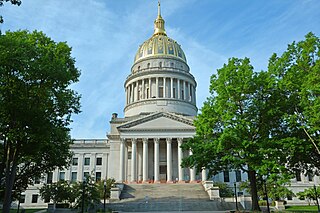
The West Virginia State Capitol is the seat of government for the U.S. state of West Virginia, and houses the West Virginia Legislature and the office of the Governor of West Virginia. Located in Charleston, West Virginia, the building was dedicated in 1932. Along with the West Virginia Executive Mansion it is part of the West Virginia Capitol Complex, a historic district listed on the National Register of Historic Places.

The Wood County Courthouse is a public building in downtown Parkersburg, West Virginia, in the United States. The courthouse was built in 1899 at a cost of $100,000 in the Richardsonian Romanesque style by local contractors Caldwell & Drake, according to the plans of architect L. W. Thomas of Canton, Ohio. The current courthouse is the fifth to be built in the county replacing one built in 1860. It was added to the National Register of Historic Places in 1979 for its architectural significance. During his 1912 presidential campaign Theodore Roosevelt stopped in Parkersburg and spoke from the Market street entrance of the courthouse. On 2 July 2020 a new steeple was added to the bell tower replacing one that had been removed in 1952. With the new steeple the courthouse is now the tallest in the state at 164 ft.

The Alexander Campbell Mansion, also known as Campbell Mansion or Alexander Campbell House, is a historic house on West Virginia Route 67 just east of Bethany, West Virginia. Built in 1793 and repeatedly enlarged, it was the home of minister Alexander Campbell (1788–1866) following his marriage in 1811. Known as the "sage of Bethany", Campbell was one of the most prominent early leaders of the Restoration Movement in United States Christianity, beginning in 1812, which resulted in formation of numerous congregations of the Disciples of Christ and Churches of Christ. The house, now a museum maintained by Bethany College, was designated a National Historic Landmark in 1994.
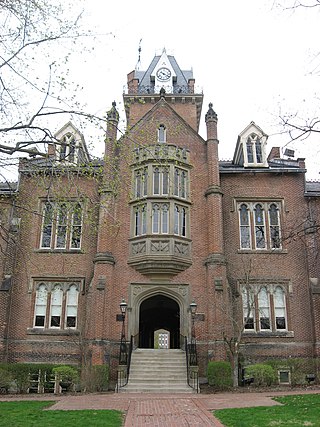
Old Main, Bethany College is a historic building group on the Bethany College campus in Bethany, West Virginia.
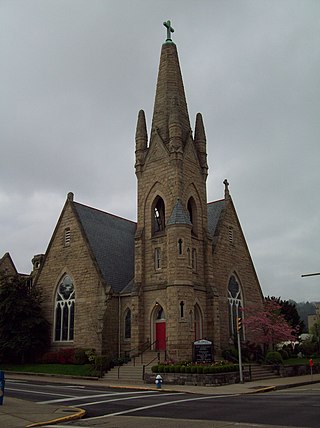
St. John's Episcopal Church is an historic Episcopal church located at 1105 Quarrier Street in Charleston, West Virginia, in the United States. On November 2, 1989, it was added to the National Register of Historic Places. It was also listed as a contributing property in the Downtown Charleston Historic District in 2006.
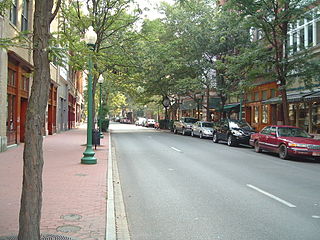
Downtown Charleston Historic District is a national historic district located at Charleston, West Virginia, USA. The district contains contributing structures in the Late Victorian and Late 19th and 20th Century Revivals architectural styles. St. John's Episcopal Church (1884), the Basilica of the Co-Cathedral of the Sacred Heart (1897), and Woodrums' Building (1916) are contributing properties.
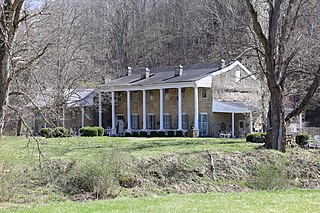
Salt Sulphur Springs Historic District is a national historic district located at Salt Sulphur Springs, near Union, West Virginia, Monroe County, West Virginia. The district includes seven contributing buildings, three contributing sites, and two contributing structures related to the Old Salt Sulphur Springs Resort or "Old Salt." Notable properties include the Old Stone Hotel, Episcopal Chapel, Stone Store Building (1820), Stone Bath House (1820), Stone Spring House, Sweet Sulphur Springs Site, Salt Sulphur Spring, and Iodine Spring (1838). It is the area's most significant collection of native limestone buildings.
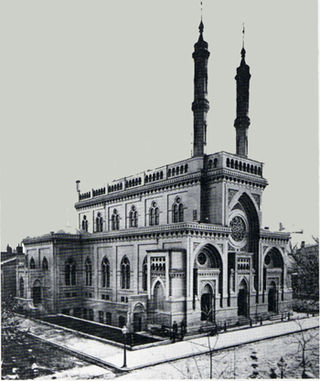
James Keys Wilson was a prominent architect in Cincinnati, Ohio. He studied with Charles A. Mountain in Philadelphia and then Martin E. Thompson and James Renwick in New York, interning at Renwick's firm. Wilson worked with William Walter at the Walter and Wilson firm, before establishing his own practice in Cincinnati. He became the most noted architect in the city. His Old Main Building for Bethany College and Plum Street Temple buildings are National Historic Landmarks. His work includes many Gothic Revival architecture buildings, while the synagogue is considered Moorish Revival and Byzantine Architecture.
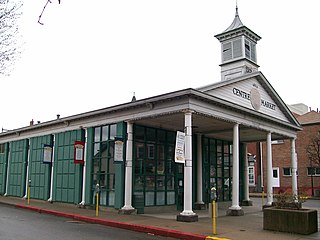
The Center Wheeling Market is a historic public market located along Market Street between 22nd and 23rd Streets in Wheeling, Ohio County, West Virginia. It consists of the Center Wheeling Market building as well as the Center Wheeling Fish Market. The 1853 Center Wheeling Market building was designed by architect Thomas Pope as an open market. The building is of neo-classical style with three bays and structural cast iron Doric order columns. It has a gable roof and features a belfry complete with bell. The 1890 open brick, neo-Romanesque section was designed by Wheeling architect Edward B. Franzheim. It has brick piers that support a hipped roof with cross gables and a three-foot overhang. In 1900, a wooden enclosure was built at the northern bay to house the Center Wheeling Fish Market.

Cameron Downtown Historic District is a national historic district located at Cameron, Marshall County, West Virginia. It encompasses 27 contributing buildings in the commercial core developed after a severe fire in 1895 which destroyed much of the downtown area. They are large 2-4 story brick buildings reflecting the Classical Revival and Colonial Revival styles. Notable buildings include the Masonic Lodge 17, Romine Building/Moose Lodge 758, First Presbyterian Church (1907), First United Methodist Church (1894), Hotel Main, Finlayson's 5 & 10/ Senior Citizens Building, Flatiron Building (1896), First Christian Church of Cameron (1896), and Old B&O Freight Station (1878).

Alderson Historic District is a national historic district located at Alderson, Greenbrier County and Monroe County, West Virginia. The district encompasses 196 contributing buildings and three contributing sites located in the commercial district and surrounding residential section. They are predominantly 19th and early 20th century frame detached residences and masonry commercial buildings including notable examples of the Federal, Greek Revival, and Queen Anne styles. Notable buildings include the Woodson Mohler Grocery building, Johnson and Gwinn warehouse, Greenbrier Mill, First National Bank building, Alderson's Store, Chesapeake and Ohio depot, U.S. Post Office, and the City Hall (1939). The Alderson Ferry Site is for the ferry established 1789. Located in the district is the separately listed Alderson Bridge.

Point Pleasant Historic District is a national historic district located at Point Pleasant, Mason County, West Virginia. The district includes 93 contributing buildings and one contributing site in Point Pleasant's central business district and surrounding residential areas. They are in a variety of late 19th- and early 20th-century architectural styles. Notable buildings include the Mansion House (1796), The Church of Christ in Christian Union (1840), Odd Fellows Hall, The Presbyterian Church (1926), Christ Episcopal Church (1869-1873), "Hooff's Opera House" (1905), Pioneer Cemetery, U.S. Post Office Building (1913), and the Poffenbarger House. The Point Pleasant Battleground is located in the district and listed separately on the National Register of Historic Places.
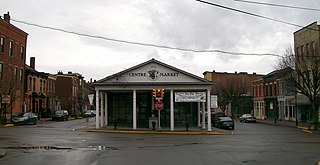
Centre Market Square Historic District is a historic district in Wheeling, West Virginia, listed on the National Register of Historic Places.

Monroe Street East Historic District is a national historic district located at Wheeling, Ohio County, West Virginia. The district encompasses six contributing buildings. They are a Greek Revival style church built in 1837, a Roman-Tuscan style dwelling dated to 1852 and known as the Paxton-Reed House, and an eclectic 1881 dwelling. Also in the district is a Richardsonian Romanesque style apartment building and a set of vernacular post-American Civil War townhouses.

North Wheeling Historic District is a national historic district located at Wheeling, Ohio County, West Virginia. The district encompasses 134 contributing buildings and one contributing object in a 2 1/2-block section of northern Wheeling, known as "Old Town". Most of the district consists of mid-to late-19th-century residential buildings. A number of popular architectural styles are represented, including Greek Revival, Italianate, and Late Victorian. Notable buildings include the Vigilant Engine House, William Goering House (1885), Alfred Paull House (1880s), Williams Duplex Tenement (1880–1884), George W. Eckhart House (1891–1892), Christian Hess House (1876), Edward Hazlett House (1893), Henry K. List House (1858). The object is the Pollack Memorial Monument (1916).

Wheeling Historic District, also known as the Wheeling Central Business District, is a national historic district located at Wheeling, Ohio County, West Virginia. The district includes 205 contributing buildings in the central business district of Wheeling. It includes the site of the original location of Fort Henry. The buildings are representative of a number of popular architectural styles from the early-19th century through the present including Greek Revival and Late Victorian. The District was listed on the National Register of Historic Places in 1979.
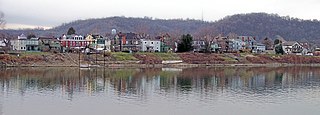
Wheeling Island Historic District is a national historic district located on Wheeling Island in Wheeling, Ohio County, West Virginia. The district includes 1,110 contributing buildings, 5 contributing sites, 2 contributing structures, and 3 contributing objects. It is a largely residential district consisting of two-story, frame detached dwellings built in the mid- to late-19th and early-20th century, including the Irwin-Brues House (1853) and a number of houses on Zane Street. The houses are representative of a number of popular architectural styles including Bungalow, Italianate, Queen Anne, and Colonial Revival. Notable non-residential contributing properties include the Exposition Building (1924), Thompson United Methodist Church (1913-1915), Madison School (1916), firehouse (1930-1931), the Bridgeport Bridge (1893), the Aetnaville Bridge (1891), "The Marina," Wheeling Island Baseball Park, and "Belle Island Park." It includes the separately listed Wheeling Suspension Bridge, Harry C. and Jessie F. Franzheim House, and John McLure House.
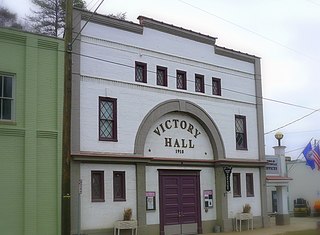
Scottsville Historic District is a national historic district located at Scottsville, Albemarle County and Fluvanna County, Virginia. The district encompasses 153 contributing buildings, 1 contributing site, and 4 contributing structures in the town of Scottsville. The district includes commercial, residential, religious, factory and warehouse buildings in a variety of popular architectural styles including Federal, Georgian, Greek Revival, Gothic Revival, Italianate, Queen Anne, Prairie, Colonial Revival, and Craftsman. Notable buildings include Scottsville High School (1920), Riverview (1817), Chester (1847), Belle Haven, Oakwood, Herndon House (1800), The Tavern (mid-1700s), Scottsville Presbyterian Church (1832), Disciples Church (1846), Coleman's Store (1914), and the Fore House (1732). Located in the district and separately listed are Cliffside and Mount Walla.

Smithfield Historic District is a national historic district located at Smithfield, Isle of Wight County, Virginia. It encompasses 289 contributing buildings and 2 contributing structures in the historic downtown and surrounding residential areas of Smithfield. There are 211 houses, 37 commercial buildings, 1 warehouse, 4 churches, 10 barns, 1 smokehouse, 23 garages, 1 farm office, 1 colonial kitchen, and 2 corncrib structures. Notable buildings include the original county clerk's office (1799), county jail, Wentworth-Barrett House, Wentworth–Grinnan House, King-Atkinson House, Smith-Morrison House (1770s), Hayden Hall, Boykin House, Goodrich House (1886), Thomas House (1889), Smithfield Academy (1827), Christ Episcopal Church, and Hill Street Baptist Church (1923). Located in the district and separately listed are the Old Isle of Wight Courthouse, Smithfield Inn, Windsor Castle Farm, and P. D. Gwaltney Jr. House.























